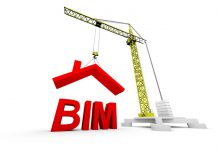The new BIM Level 2 website hosts the suite of standards and outlines the processes and information management practices required to perform at this maturity level. Here, Stephanie Kosandiak, Lead Programme Manager for Construction at BSI, discusses what is on offer…
In the construction and asset management industry, the use of a Building Information Model (BIM) which is shared by partners is becoming more and more commonplace. BIM is the collaborative way of working underpinned by digital technologies. These technologies allow for more efficient methods of designing, delivering and maintaining physical built assets throughout their entire lifecycle.
The widely accepted concept of BIM maturity levels has been defined by the Bew-Richards maturity model. BIM Level 2 maturity is a series of domain and collaborative federated models. The models, consisting of both 3D geometrical and non-graphical data, are prepared by different parties during the project life-cycle within the context of a common data environment. Using proprietary information exchanges between various systems, project participants will have the means necessary to provide defined and validated outputs via digital transactions in a structured and reusable form.
Why has BIM Level 2 been introduced?
In May 2011, the UK Government published the Construction Strategy aimed at reducing the cost of public sector assets by up to 20% by 2016. To achieve this strategy, the government requires construction suppliers tendering for centrally-procured government projects to be working at BIM Level 2. As a minimum, they require fully collaborative 3D BIM (with all project and asset information, documentation and data being electronic). The requirement has been introduced to drive the adoption of BIM processes throughout the public and private sector. While this requirement was introduced initially for government projects, the benefits of utilizing BIM Level 2 processes and information management practices can also be realised by private sector clients and projects within the construction industry.
How to implement BIM Level 2
The adoption of BIM Level 2 by the construction and asset management industry requires organizations and individuals to embrace change and accept that traditional roles within the supply chain and client organization may need to be redefined to successfully implement the new processes and information management requirements.
This is where the role of standards and guidance is important. The suite of standards to support industry in the adoption of BIM Level 2 outline the processes and information management practices required to perform at this maturity level. The British Standards and Publicly Available Specifications (PAS) from BSI are available to download.
Key benefits of using BIM
BIM allows design and construction teams to communicate about design and coordinate information across different levels that has been unseen before. This information remains with the project, from before beginning construction, right throughout its lifetime. It also helps to analyse any potential impacts. The use of BIM goes beyond the planning and design phase of the project, extending throughout the building life cycle, supporting processes including cost management, construction management, project management and facility operation. The adoption of BIM requires organizations and individuals to change the way they work. They must accept that traditional roles within the supply chain and client organizations may need to be redefined to successfully implement the new processes and information management requirements of BIM. Some benefits include:
• Reduction in CAPEX, delivery, and operational costs
• Reduced risk
• Improved carbon performance
• Predictable planning
• Faster and efficient processes
• Increased productivity and speeds up delivery
• Reduced uncertainty
• Controlled whole-life costs and environmental data
• Avoidance of rework costs
• Improved safety
• Opportunity to secure Government contracts and meet BIM Level 2
• Reduced on-site waste
• Prevention of errors
As the construction industry is being revolutionized by the increasing adoption of BIM, it’s crucial that businesses know what it may mean for them.
The BIM Level 2 website
This has been developed as a point of reference for clients, designers, contractors, trade suppliers, manufacturers, maintainers, operators and users to understand how to use BIM and data to improve productivity and reduce waste. Work has been undertaken over the past four years in a joint Government – Industry Working Group or BIM Task Group to provide Standards, guides, case studies and shared experiences to help all stakeholders with their BIM adoption journey.
Guidance is being commissioned especially for the website with ten chapters for the UK construction market and seven aimed at the overseas market.
What guidance will be available on the BIM level 2 website?
• BIM Level 2 Guidance: UK Edition
This guidance will look at the following 10 chapters: Introduction (PDF); what BIM Level 2 is; the BIM Level 2 processes and tools and how are they used; Operational Management of Assets; Project and Programme Briefing; Capital Delivery of Assets; Asset and Data Security; Demystifying BIM Level 2 data – data classification and management; Procuring Systems – data and asset management and BIM Level 2 for the sub – contract supply chain
• BIM Level 2 Guidance: International Edition
This guidance will look at the following 7 chapters: Introduction (PDF); why the UK Government BIM Strategy was developed; Introduction – size of the opportunity; what the key components of the UK BIM Strategy are and how they work; what the BIM Level 2 processes and tools are and how they are used; Lessons learned from the UK BIM Strategy and Summary – the Investor Guide for public sector BIM strategy.
This technical specification is intended to provide a consistent methodology for the definition, creation, management and sharing of product information through the life cycle of an asset based on the purpose of that information, and who the information is to be used by. It does not constitute a standard that has been developed through a recognized and independent consensus-building process. It should therefore not be regarded as a formal British Standard or a BSI PAS. Please provide any feedback on the technical specification to productdata@bim4m2.co.uk
Over the next six months, the final standards guidance and tools will become available on the website. There will be regular updates through to Autumn 2016 where the new national and international guides and case study materials will be available. For more information visit http://bim-level2.org/
. . . . . . . . . . . . . . . . . . . . . . . . . . . . . . . . . . . . . . . . . . . . . . .
Stephanie Kosandiak
Lead Programme Manager for Construction
BSI (British Standards Institution)
Tel: +44 (0)20 8996 6330













